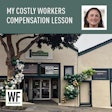

Playing armchair quarterback on Sunday afternoon is certainly easier than developing strategies for increasing your company's profits. Most people are eager to offer their suggestions for what their team needs to change to be successful. If they concentrated just as much energy on directing their business team, they could easily make changes to improve profitability. When trying to make these changes, however, there is often some confusion about where to focus the company's efforts. The problem is that all the players — sales generation, pricing, inventory control, collections and along list of other factors — seem important. While in the middle of the action, it can be difficult to sort all the players out. Which should be the priority?
In the planning process, it is vital to have a clear understanding which players have the greatest impact on performance. This article attempts to shed some light on profit priorities by exploring the two main profitability game plans and then helping design a playbook for your business for the future. Your future playbook will suggest how to make changes in high-priority areas.
Two profitability game plans
Two very distinct financial philosophies guide management actions in business today. One concentrates on profit margins, and the other on asset investment. Both have value, but they lead the company to two very different sets of actions. Even more important, they have different impacts on overall profitability.
A profit margin orientation focuses the company on the factors that appear to drive the bottom line on a day-to-day basis. This means the company:
- Tries to maintain sales momentum even if the economy is soft
- Attempts to hold the line on gross margin despite price pressures
- Reviews operating expenses with a critical eye.
On the other hand, an asset investment orientation suggests that it is difficult to improve profit margin factors unless there is a growing economy. It places emphasis on the key elements of working capital. For the typical hardwood flooring business, this means examining the investment in inventory and accounts receivable.
These two philosophies are not mutually exclusive. In practice, however, most companies tend to emphasize one group of factors over the other. In doing so, they are setting limits on potential improvement.

Eyeing the bottom line
Using a profit margin approach, Figure 1 shows the impact that a 1 percent improvement in four key profit margin drivers — sales, pricing, buying and expenses — have on overall profit results. The figures are based on the performance of the typical wood flooring business. While different companies in the industry have different numbers, they all will be relatively close to the industry norms in Figure 1.
In the "sales increase" column, the number of units sold is increased by 1 percent with no increase in operating expenses. Similarly, the"price increase" column means that prices are increased by 1 percent with no loss of unit volume. The "improved buying" column reflects a 1 percent reduction in cost of goods sold. Finally, the "expense reduction" column demonstrates a 1 percent expense reduction without any loss of sales volume.
There are two important implications in Figure 1. First and foremost, the relative size of the different factors should be well understood. Changes in the two gross margin factors, pricing and buying, have the largest impact on overall results. The third factor in terms of its impact is sales volume, followed closely by expenses. In fact, the difference between the impact of a sales increase and an expense decrease is negligible.
Second, the numbers also work in reverse. That is, if prices are lowered by 1 percent, then profit is reduced by the exact same amount shown in Figure 1. This is important in times of economic uncertainty, when price pressures tend to create profit challenges.
Playing with investments
Using an asset investment approach, Figure 2 outlines the same type of analysis for the primary asset investments — inventory and accounts receivable. Since their profit impact follows a different path, a more extensive figure is required. It examines the impact of a reduction in the investment level and its impact on carrying costs.
For the "inventory reduction" column, a carrying cost of 15 percent was used. This represents interest, property taxes, insurance and the other costs of carrying inventory for a year. For the "accounts receivable reduction" column, a 10 percent carrying cost was used, which represents interest and bad debts.
Figure 2 also tracks much larger changes than Figure 1. For inventory and accounts receivable, reductions on the magnitude of 5 percent are often possible,so this percentage was used for Figure 2. Even with this relatively large reduction, however, the profit improvement results are surprisingly modest.
The reality is that improving the working capital factors has a much smaller profit impact than does improving the profit margin factors. This does not mean working capital is unimportant. In particular, the impact of inventory and accounts receivable on cash flow is significant. However, it does suggest that any profit improvement effort that focuses on working capital to the exclusion of profit margin is doomed to failure.
Designing the future playbook
The two figures suggest the relative impact of modest improvements. They do not show how easily those improvements can be made. Some areas hold much greater potential for improvement than others. You need to determine where the greatest opportunity for actual improvement really lies.
Despite the limitations of the figures, they do demonstrate three points:
- Very small improvements in pricing and buying will help the company increase profits significantly.
- Moderate improvements are required in sales volume and operating expenses to produce the same impact.
- Significant reductions are necessary in inventory and accounts receivable to generate the same increase in profitability. These differences need to be kept in mind when developing improvement plans.
Gross margin — a key player

The effect of pricing and buying improvements overwhelms everything else in Figure 1. The figure does not suggest that companies should raise prices indiscriminately. What it does say, though, is that the profit impact from changes in pricing and buying is so large that it must be given first priority. The problem, of course, is that raising prices can be a seemingly impossible undertaking given the number and diversity of competitors. Obtaining better prices from suppliers is also extremely difficult.
Having said that, financial results indicate that the most profitable companies in the industry are the ones with the best gross margins. They have been able to develop more effective programs for dealing with the margin issue. The strategies proven most successful have included:
- Developing a true value-added approach
- Niche marketing efforts that focus on more service-oriented customers
- Tight control over product mix to ensure that margins are maintained
- Heavy reliance on internal control systems to reduce gross margin slippage's such as markdowns, shrinkage, accounting errors and the like.
Sales/expenses — second string
Increasing unit sales by 1 percent or cutting expenses by 1 percent both have about the same level of impact on profits. While the profit increases are quite substantial, they are decidedly less powerful than pricing and buying.
The similarity of the two results indicates that any adjustment in physical activity will have about the same impact on results. This is true whether sales volume is enhanced by 1 percent or the level of overhead expense is reduced by 1 percent.
Companies need to be more concerned about sales productivity (sales generated relative to the expense of producing those sales) than they have in the past. From an operational perspective, this means:
1. Focused marketing attention on the more profitable customers
2. Spending as much time and effort on the retention of current customers as on finding new customers
3. Developing a zero-based budgeting approach to every expense item.
Assets—a secondary player
Finally, reducing the asset investment, be it inventory or accounts receivable, has only a modest impact on profit results. The cash flow impact is large, of course, but the profit impact is minor.
The reasons for the small impact are two-fold. First, interest rates are exceedingly low, which minimizes the cost savings of any asset reduction program. Second, most companies have already worked hard to eliminate dead items and cut the collection period. The opportunities for additional improvement tend to become scarce.
Incremental efforts regarding asset investment should consist of doing more of the same — item reduction and faster collection. Such approaches must betaken with care. Nothing done in the investment arena should have a negative impact on either gross margin or sales.
Moving forward
If your company is interested in improving profit results, use the numbers in Figure 1 as the basis for action. The primary emphasis should be on gross margin enhancement, with a secondary emphasis on sales volume and cost control. The investment levels should be of third string importance. Improving your company's profitability may require sometime to strategize, but achieving financial goals can be accomplished when you make the right moves.
































